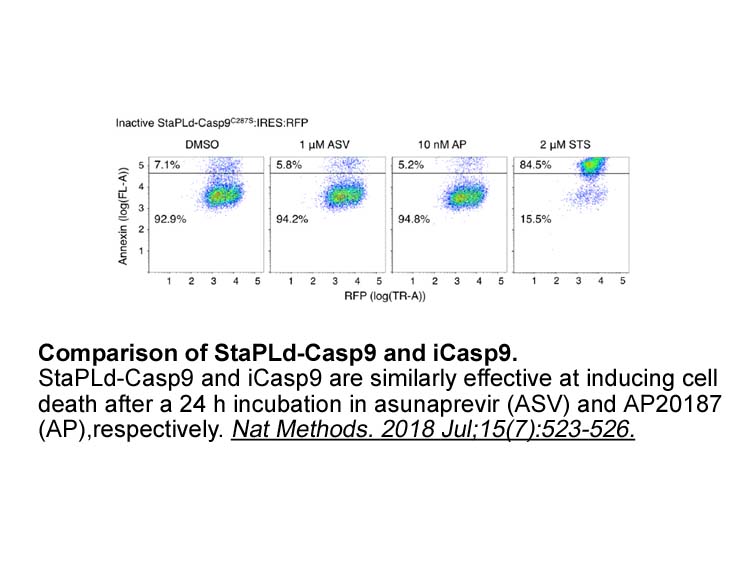Archives
It has been reported that NLRP product caspase
It has been reported that NLRP3 product, caspase-1, is increased in the brains of AD patients and experimental AD animals. NLRP3- and caspase-1-deficient animals are resistant to experimental development of AD, and have decreased IL-1β production and significantly increased Aβ clearance (Heneka et al., 2013).
Moreover, Aβ phagocytosis by microglia induces phagolysosome destabilization and consequent release of cathepsin B into the cytosol, which, in turn, ac ts as an endogenous NLRP3 agonist (Halle et al., 2008). It was recently shown that microglia, but not astrocytes, possess NLRP3 inflammasome machinery and exhibit NLRP3 activation after stimulation with Aβ aggregates, being probably the main CNS Obeticholic Acid responsible for the inflammatory response via NLRP3 (Gustin et al., 2015). In vivo experiments reported that this inflammasome activation increases the deposition of Aβ peptide, thus exacerbating the pathology in transgenic AD mice. Furthermore, caspase-1 inhibition leads to a decrease in IL-1β levels, which, in turn, reduces the neurotoxic effects of microglia by reducing the production of ROS (Parajuli et al., 2013). This suggests a central role of inflammasome NLRP3 in the development of AD.
ts as an endogenous NLRP3 agonist (Halle et al., 2008). It was recently shown that microglia, but not astrocytes, possess NLRP3 inflammasome machinery and exhibit NLRP3 activation after stimulation with Aβ aggregates, being probably the main CNS Obeticholic Acid responsible for the inflammatory response via NLRP3 (Gustin et al., 2015). In vivo experiments reported that this inflammasome activation increases the deposition of Aβ peptide, thus exacerbating the pathology in transgenic AD mice. Furthermore, caspase-1 inhibition leads to a decrease in IL-1β levels, which, in turn, reduces the neurotoxic effects of microglia by reducing the production of ROS (Parajuli et al., 2013). This suggests a central role of inflammasome NLRP3 in the development of AD.
Crosstalk between dyslipidemia and inflammation in AD
Systemic inflammation can be exacerbated by obesity and is linked to neuroinflammatory processes in several disorders. For example, HFD-fed mice have increased BBB disruption and microglial oxidative stress (Tucsek et al., 2014), as well as increased microglial and astrocytic reactivity (Pistell et al., 2010), which can be related to an increase in leptin levels (Koga et al., 2014). In both aging mice and a mouse model of AD, there is an increased astrocytic and microglial activation after a long-term western diet, associated with an increased expression of TREM2 within these glial cells (Graham et al., 2016). In aged obese mice, there is higher vascular ROS generation, vascular inflammation and proinflammatory factors release in fat perivascular tissue, all inducing vascular wall changes (Bailey-Downs et al., 2013). Cholesterol-rich diets can also increase the levels of several inflammatory cytokines in the hippocampus of reproductive senescent female rats (Lewis et al., 2010a). This is of great importance, since proinflammatory cytokines play an important part in synaptic plasticity and membrane excitability (Schreurs, 2010). Another study also reported a genetic overlap between AD, C-reactive protein and plasma lipids (e.g. triglycerides, HDL and LDL) (Desikan et al., 2015).
NLRP3 inflammasome activation can be induced either by phagocytosis of cholesterol crystals, with lysosomal disruption, or activation of complement pathways by cholesterol, both resulting in subsequent caspase-1 activation and IL-1β release (Duewell et al., 2010, Samstad et al., 2014). These events indicate that the association between cholesterol and inflammasome is a connection between lipid metabolism and inflammation, which are two important processes in AD. This is corroborated by lysosomal deregulation and NLRP3 inflammasome activation on macrophages, induced by CD36-mediated Aβ endocytosis (Sheedy et al., 2013).
Not surprisingly, cholesterol metabolism is implicated in inflammatory processes associated with AD pathogenesis. In rats, hypercholesterolemia is involved in decreased cholinergic activity, increased microglial activation and increased inflammatory factors levels (Ullrich et al., 2010). Additionally, in an animal model of AD, changes mediated by hypercholesterolemia contributed to cognitive dysfunction (Thirumangalakudi et al., 2008).
In this context, it has been reported that the levels of peroxisome proliferator-activated receptors (PPARs) alpha and gamma (ligand-activated transcription factors for lipid metabolism with paramount role in anti-inflammatory processes) are disrupted in AD. While mRNA and protein levels of PPAR gamma are elevated, which is a protective mechanism, PPAR alpha are reduced. It is worth mentioning that the use of agonists of both isoforms has beneficial effects in the treatment of AD (D'Agostino et al., 2012, Vallee and Lecarpentier, 2016). In addition, AD-patients’ PBMCs exhibit reduced mRNA levels of sterol regulatory element-binding protein-2 (SREBP-2), known as a main regulator of cholesterol homeostasis (Mandas et al., 2012). On the other hand, overexpression of SREBP-2 worsens Aβ-induced oxidative stress, neuroinflammation and neurodegeneration, leading to increased microglial and astrocytic activation. This is likely because overexpression of SREBP-2 downregulates the expression of genes involved in Aβ metabolism (Fernandez et al., 2009, Barbero-Camps et al., 2013).